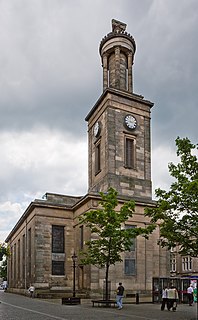
Elgin is a town and formerly a Royal Burgh in Moray, Scotland. It is the administrative and commercial centre for Moray. The town originated to the south of the River Lossie on the higher ground above the floodplain where the town of Birnie is. There, the church of Birnie Kirk was built in 1140 and serves the community to this day. Elgin is first documented in the Cartulary of Moray in 1190 AD. It was created a royal burgh in the 12th century by King David I of Scotland, and by that time had a castle on top of the present-day Lady Hill to the west of the town. The origin of the name Elgin is likely to be Celtic. It may derive from 'Aille' literally signifying beauty, but in topography a beautiful place or valley. Another possibility is 'ealg', meaning both 'Ireland' and 'worthy'. The termination 'gin' or 'in' are Celtic endings signifying little or diminutive forms, hence Elgin could mean beautiful place, worthy place or little Ireland.
Forres is a town and former royal burgh in the north of Scotland on the Moray coast, approximately 25 miles (40 km) northeast of Inverness and 12 miles (19 km) west of Elgin. Forres has been a winner of the Scotland in Bloom award on several occasions. There are many geographical and historical attractions nearby such as the River Findhorn, and there are also classical, historical artifacts and monuments within the town itself, such as Forres Tolbooth and Nelson's Tower. Brodie Castle, the home of the Brodie Clan, lies to the west of the town, close to the A96.

Lossiemouth is a town in Moray, Scotland. Originally the port belonging to Elgin, it became an important fishing town. Although there has been over 1,000 years of settlement in the area, the present day town was formed over the past 250 years and consists of four separate communities that eventually merged into one. From 1890 to 1975, it was a police burgh as Lossiemouth and Branderburgh.

Burghead is a small town in Moray, Scotland, about 8 miles (13 km) north-west of Elgin. The town is mainly built on a peninsula that projects north-westward into the Moray Firth, surrounding it by water on three sides. People from Burghead are called Brochers.

The Scott Monument is a Victorian Gothic monument to Scottish author Sir Walter Scott. It is the second largest monument to a writer in the world after the José Martí monument in Havana. It stands in Princes Street Gardens in Edinburgh, opposite the Jenners department store on Princes Street and near to Edinburgh Waverley Railway Station, which is named after Scott's Waverley novels.

Dunkeld is a town in Perth and Kinross, Scotland. The location of a historic cathedral, it lies on the north bank of the River Tay, opposite Birnam. Dunkeld lies close to the geological Highland Boundary Fault, and is frequently described as the "Gateway to the Highlands" due to its position on the main road and rail lines north. Dunkeld has a railway station, Dunkeld & Birnam, on the Highland Main Line, and is about 25 kilometres north of Perth on what is now the A9 road. The main road formerly ran through the town, however following modernisation of this road it now passes to the west of Dunkeld.

Nairn railway station is a railway station serving the town of Nairn in Scotland. The station is managed by ScotRail and is on the Aberdeen to Inverness Line. It is a category B listed building. The station appeared as 'Inverness' in the 1970 film The Private Life of Sherlock Holmes.
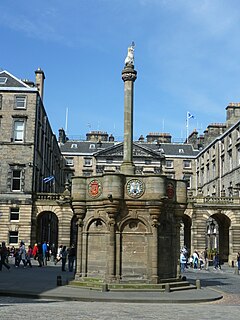
A mercat cross is the Scots name for the market cross found frequently in Scottish cities, towns and villages where historically the right to hold a regular market or fair was granted by the monarch, a bishop or a baron. It therefore served a secular purpose as a symbol of authority, and was an indication of a burgh's relative prosperity. Historically, the term dates from the period before 1707, when the Kingdom of Scotland was an independent state, but it has been applied loosely to later structures built in the traditional architectural style of crosses or structures fulfilling the function of marking a settlement's focal point. Historical documents often refer simply to "the cross" of whichever town or village is mentioned. Today, there are around 126 known examples of extant crosses in Scotland, though the number rises if later imitations are added.

Spynie Palace, also known as Spynie Castle, was the fortified seat of the Bishops of Moray for about 500 years in Spynie, Moray, Scotland. The founding of the palace dates back to the late 12th century. It is situated about 500 m from the location of the first officially settled Cathedral Church of the Diocese of Moray, Holy Trinity Church in present-day Spynie Churchyard. For most of its occupied history, the castle was not described as a palace — this term first appeared in the Registry of Moray in a writ of 1524.

The Bridge of Dee or Brig o Dee is a road bridge over the River Dee in Aberdeen, Scotland. The term is also used for the surrounding area of the city. Dating from 1527, the bridge crosses at what was once the City of Aberdeen's southern boundary. This was the site of a battle in 1639 between the Royalists under Viscount Aboyne and the Covenanters who were led by the Marquess of Montrose and Earl Marischal. This was the only substantial action of the First Bishops' War, and it took place after the peace treaty had already been signed.

Portgordon, or sometimes Port Gordon, is a village in Moray, Scotland, 2 km south-west of Buckie. It was established in 1797 by Alexander Gordon, 4th Duke of Gordon as a fishing village. It had a population of 844 at the time of the 2011 census. Currently the Portgordon Community Harbour Group is trying to regenerate the harbour and open a marina.
The Muckle Spate was a great flood in August 1829, which devastated much of Strathspey, in the north east of Scotland.

The Duke of Gordon's Monument is a commemorative monument on Lady Hill near Elgin, Scotland. Built in honour of George Gordon, the 5th Duke of Gordon, the monument takes the form of a Tuscan column, 80 feet (24 m) high, and 6 feet 9 inches (2.06 m) wide at the base. The column is hollow, with a spiral staircase leading up the shaft which gives access to the top. It was erected in 1839, and a statue of Gordon, sculpted by Thomas Goodwillie, was installed on the top in 1855. It is designated as a Category A listed building.
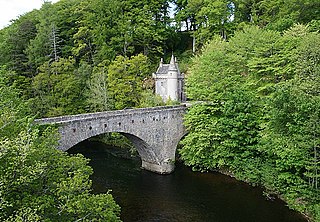
The Bridge of Avon is a bridge over the River Avon at Ballindalloch in Moray, Scotland, built between 1800 and 1801 by George Burn. The bridge is mainly rubble-built, with an abutment on the south bank, and a pier with a cutwater on the north bank, of tooled ashlar. It crosses the river in a single wide segmental arch, with a smaller flood arch on the north bank.

The Old Spey Bridge is a footbridge on the outskirts of Fochabers in Moray, Scotland, which formerly carried the main road between Inverness and Aberdeen over the River Spey. Originally built between 1801–1806 by George Burn, it was partially destroyed in the Muckle Spate of 1829, with two of its arches being washed away. Archibald Simpson repaired the bridge in 1831 with a single timber span, which was reconstructed in cast iron in 1853. The bridge is designated a Category A listed building.
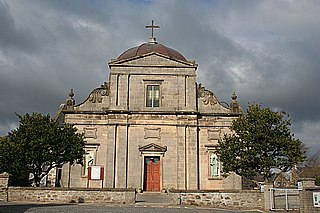
St Thomas's Church is a Roman Catholic church in Keith, in Moray, Scotland. It is a cruciform building, exhibiting features of neoclassical and baroque architecture, with an elaborate east-facing facade, and north and south transepts with stained glass windows. Originally designed by Walter Lovi and William Robertson in the early 1830s, its large copper dome was added in 1916 by Charles Ménart, who also remodelled the interior. It has been designated a Category A listed building.
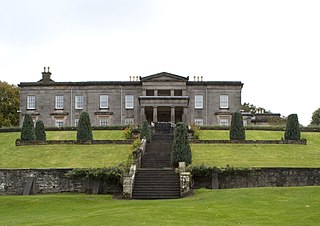
Aberlour House is a country house near Aberlour in Moray, Scotland. It was built in 1838 by William Robertson for Alexander Grant, planter and merchant from Aberlour, after his return to the UK. His niece, Margaret Macpherson Grant, lived in it after Grant died, and it was later home to John Ritchie Findlay of The Scotsman newspaper and his descendants. It was requisitioned for military use during the Second World War, and after the war was sold for use as a preparatory school for Gordonstoun. The school was later moved into Gordonstoun's estate, and the building was sold to Walkers Shortbread, who restored and renovated it, and now use it as their head office. It has been designated a Category A listed building.

St Rufus Church, also known as Keith Parish Church, is a Church of Scotland church in Keith, Moray, that was built in 1816. Designed by James Gillespie Graham in the Perpendicular Gothic style, it has crenellated walls, traceried windows and a tall bell and clock tower at its west end. The doorway leading into the nave from the entrance lobby is an unusual war memorial, listing the names of parishioners who died in the First World War on one side, and in the Second World War on the other.

Milton Brodie House is a mansion near Kinloss in Moray, Scotland. Built for the Brodie family in 1710 on the site of an older tower house, it was originally called Windhills, but was renamed to commemorate the Milton estate that the family had formerly owned. In was substantially remodelled between 1835 and 1841 by William Robertson, and was designated a Category A listed building in 1989.

















